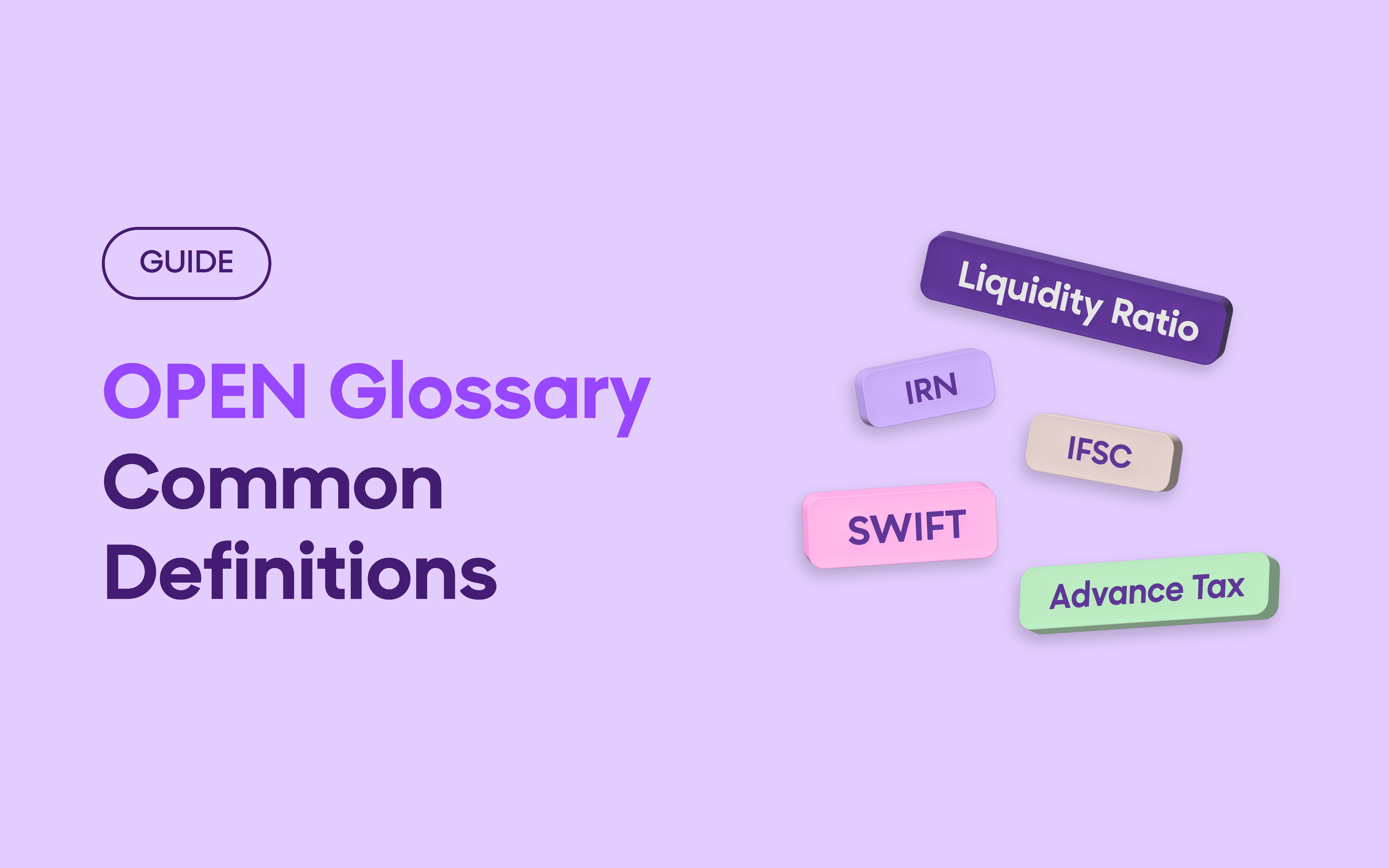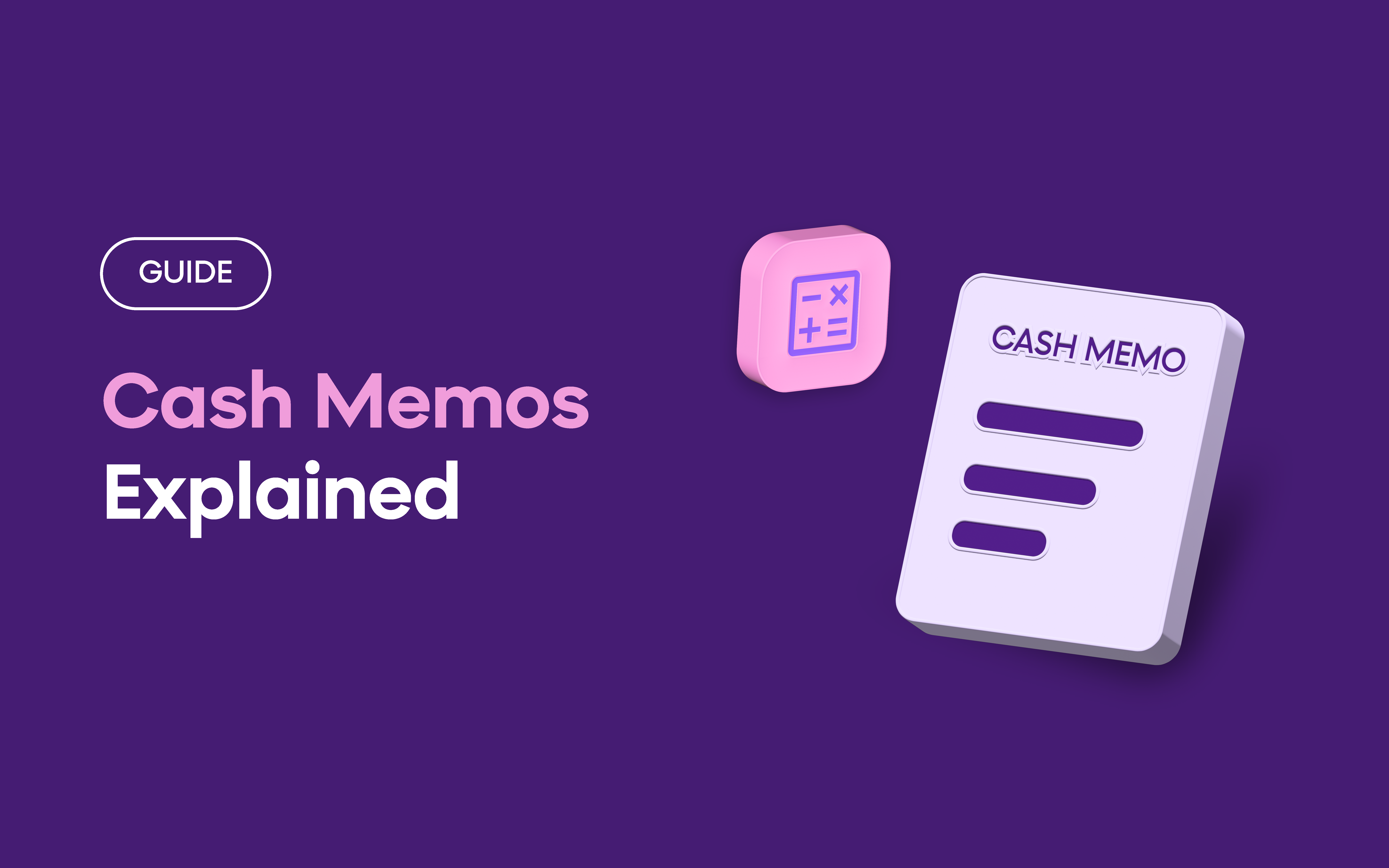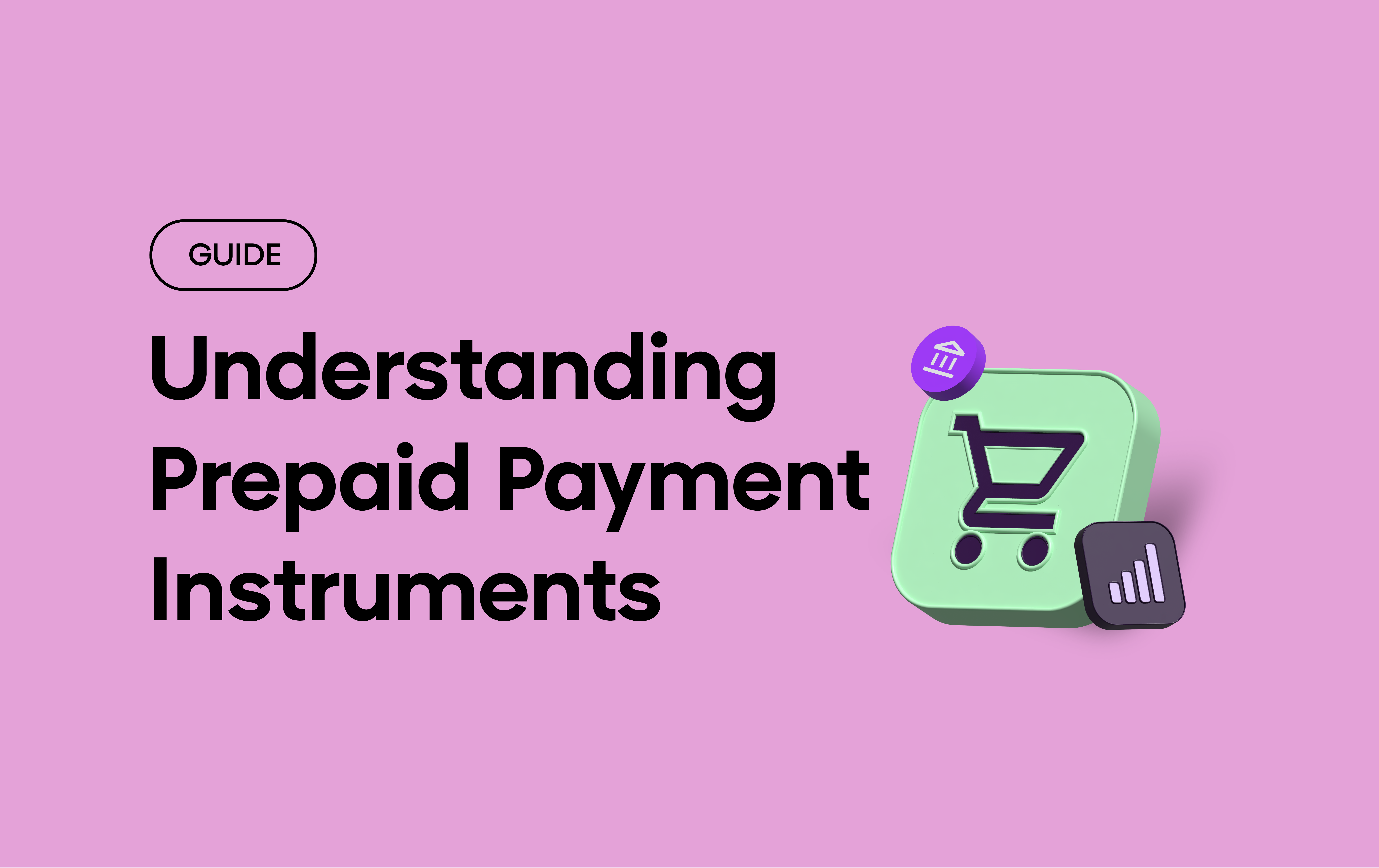Introduction
Purpose of this glossary
This glossary provides definitions of common terms you’ll encounter while using OPEN Money. It’s organized into categories for easy navigation. Each term is explained in simple, easy-to-understand language.
How to use this guide
Use this glossary as a quick reference whenever you come across unfamiliar terms. The categories make it easy to find relevant terms, and each definition is written to help you understand financial concepts without jargon.
Bookmark it for quick access whenever you come across unfamiliar terms!
Payment Processing Terms
Basic Payment Concepts
| Account Number | A unique identification number assigned to a bank account, used to identify the account holder’s specific account in the bank’s system. |
| Acquirer Bank | The bank or financial institution that processes card payments on behalf of a merchant. It receives transaction requests from the payment gateway, forwards them to the card network, and settles the funds into the merchant’s account. Also known as the ‘merchant’s bank’. |
| Authorization | The process of verifying a transaction’s validity before payment is completed. |
| Chargeback | A dispute raised by the customer to reverse a payment. |
| Dispute Resolution | The process of resolving payment disputes between customers and merchants. |
| IFSC (Indian Financial System Code) | A code used to uniquely identify a bank branch for the purpose of electronic fund transfers in India. It is an alphanumeric code that consists of 11 characters, where the first four represent the bank, the fifth is a zero (0), and the last six identify the specific branch. |
| Issuer Bank | The bank that issues a debit or credit card to the customer. It verifies the transaction, approves or declines the payment based on available funds or credit limit, and processes the deduction from the customer’s account. Also known as the ‘customer’s bank’. |
| Merchant Discount Rate (MDR) | The transaction fee charged by payment service providers or banks for processing payments. |
| Payment Aggregator (PA) | A service provider that enables merchants to accept payments without a direct bank integration. |
| Payment Gateway (PG) | A platform that processes online payments from customers to merchants. |
| Payment Link | A link shared with customers to collect payments online. |
| Payment Reconciliation | The process of matching payments received with invoices or transaction records to ensure accuracy and detect discrepancies. |
| Payment Status | The current state of a payment, e.g., success, failed, or pending. |
| Refund | Returning the payment to a customer’s account. |
| Settlement | Transferring funds from a payment gateway to the merchant’s bank account. |
| Transaction Fee | A charge applied to a payment transaction, usually a percentage of the transaction amount or a fixed fee. It covers the cost of processing the payment and is often shared among various parties, including banks, payment gateways, and payment aggregators. |
| Transaction ID | A unique identifier assigned to every payment transaction. |
| UTR (Unique Transaction Reference) | A reference number generated for every financial transaction conducted in India through the Real Time Gross Settlement (RTGS) or National Electronic Funds Transfer (NEFT) system. It helps track the transaction and ensures that payments can be identified and traced easily. |
Payment Methods
| BNPL (Buy Now, Pay Later) | A short-term credit option where customers can make a purchase and defer payment, usually without interest if paid within a specified period. |
| Credit Card | A card that allows users to borrow funds to make payments. |
| Debit Card | A card linked to a bank account for direct payments. |
| EMI Options (Equated Monthly Installments) | A payment method that allows customers to pay for purchases in fixed monthly installments instead of a lump sum. |
| IMPS (Immediate Payment Service) | A real-time electronic funds interbank transfer system in India that allows instant money transfers 24/7, including weekends and holidays. Cost: ₹0–25 per transaction, depending on the bank and transfer amount. Many banks offer free IMPS for online transactions. |
| NEFT (National Electronic Funds Transfer) | A bank transfer system in India that allows electronic fund transfers in batches, typically settled within a few hours. Cost: ₹0–25 per transaction, depending on the amount and bank. Many banks offer free NEFT for online transfers. |
| Net Banking | Online banking services for transferring money or paying bills. |
| Prepaid Cards | Payment cards that are preloaded with a specific amount of money and can be used for purchases or withdrawals until the balance is exhausted. |
| RTGS (Real-Time Gross Settlement) | A payment system for high-value transfers where funds are settled instantly and individually without batching. Cost: ₹0–50 per transaction, depending on the amount and bank. Usually free for online transactions. |
| SWIFT (Society for Worldwide Interbank Financial Telecommunication) | A global network that enables secure international money transfers between banks using standardized codes. Cost: Varies based on the bank, currency, and transfer amount; typically ₹500–2,500 per transaction, plus currency conversion charges. |
| SWIFT Code | A SWIFT Code is a unique identifier assigned to banks for international transactions. It ensures secure and accurate routing of funds across countries. |
| UPI (Unified Payments Interface) | A real-time payment system that allows instant money transfers via mobile devices. |
| Virtual Cards | Digital payment cards that function like physical cards but exist only online. They provide enhanced security by allowing one-time or limited-use transactions. |
| Wallets (e.g., Paytm, Amazon Pay) | Digital prepaid platforms like Paytm or Amazon Pay used for making payments. |
Accounting & Bookkeeping
General Accounting
| Accounts Payable Aging | A report that shows how much a business owes to its vendors, categorized by the due dates. It helps track overdue payments and manage cash flow effectively. |
| Accounts Receivable Aging | A report that lists outstanding customer invoices, grouped by how long they’ve been unpaid. It helps identify late payments and manage collections efficiently. |
| Accrual Accounting | Recording revenue and expenses when they occur, not when money is exchanged. |
| Audit Trail | A record that shows the history of financial transactions. |
| Bad Debt | Money owed to a business that is unlikely to be collected, often due to customer bankruptcy or prolonged non-payment. It’s recorded as a loss in accounting. |
| Balance Sheet | A financial statement showing assets, liabilities, and equity. |
| Cash Basis Accounting | An accounting method where income and expenses are recorded only when cash is received or paid, not when they are incurred. |
| Chart of Accounts | A list of accounts used for organizing financial records. |
| Fixed Assets | Long-term tangible assets like buildings, machinery, or equipment that a business uses for operations and isn’t expected to sell quickly. |
| Journal Entry | A record of a financial transaction in the accounting books. |
| Ledger | A book or digital record where all transactions are grouped by accounts. |
| Profit & Loss Statement (P&L) | A financial report that summarizes a company’s revenues, expenses, and profits or losses over a specific period, showing how the business is performing financially. |
| Trial Balance | A summary of all ledger balances to check for errors. |
Transaction-Related Terms
| Bank Statement | A record of all transactions in a bank account. |
| Credit Note | A document issued to reduce the value of an invoice. |
| Debit Note | A document issued to increase the value of an invoice. |
| GST TDS | A mechanism under GST where the buyer deducts tax at the time of payment to the supplier and remits it to the government. |
| Payables | Money a business owes to its vendors or suppliers. |
| Receivables | Money owed to a business by its customers. |
| Reconciliation | Matching financial records with bank statements to ensure accuracy. |
GST, Taxes & Compliance
Basic GST Concepts
| Composition Scheme | A simplified tax scheme for small businesses. |
| GST Registration | The process of registering a business under GST. |
| GST Return Filing | Submitting GST-related details to the government. |
| GSTIN | A unique ID for businesses registered under GST. |
| GSTN (Goods and Services Tax Network) | The digital platform managing GST operations. |
| HSN/SAC Codes | Codes used to classify goods and services under GST. |
| State Codes | Unique two-digit codes assigned to each Indian state and union territory under GST for identification in GSTIN numbers and tax filings. |
| Input Tax Credit (ITC) | Tax credit for the GST paid on purchases, which can be adjusted against GST payable on sales. |
| Output Tax | GST collected on sales of goods or services. |
| Reverse Charge Mechanism | When the recipient of goods or services pays GST instead of the supplier. |
| Zero Rated Supply | Goods or services taxed at 0% under GST. |
GST Documents
| e-Invoice | A digitally authenticated invoice generated through the Invoice Registration Portal (IRP), mandated for certain businesses under GST. |
| E-Way Bill | A document required for transporting goods worth over a certain amount. |
| GSTR-1 | The monthly or quarterly return for reporting outward supplies of goods and services made by a business. It includes details of sales, invoices, and taxes collected. |
| GSTR-10 | A final return filed by a taxpayer who has canceled their GST registration, providing details of closing stock and liabilities. |
| GSTR-11 | Filed by individuals or entities who have a Unique Identification Number (UIN) for claiming a refund of the GST paid on purchases. |
| GSTR-2A | A dynamic document that automatically reflects the details of inward supplies (purchases) from the GSTR-1 of the suppliers. It helps in verifying the input tax credit (ITC). |
| GSTR-2B | A static version of GSTR-2A, providing a summary of eligible ITC that businesses can claim for a particular month. |
| GSTR-3B | A self-assessment return where businesses summarize their total sales, purchases, and GST payable. This return is filed monthly or quarterly. |
| GSTR-4 | The return for taxpayers under the composition scheme, detailing the outward supplies and tax liability for the quarter. |
| GSTR-5 | The return for non-resident foreign taxable persons, reporting their sales and purchases in India. |
| GSTR-6 | Filed by input service distributors (ISD), detailing the distribution of credit to their branches or units. |
| GSTR-7 | Filed by taxpayers who are required to deduct tax at source (TDS) under GST, reporting the TDS deductions made. |
| GSTR-8 | Filed by e-commerce operators who are required to collect tax at source (TCS), reporting the amount of tax collected. |
| GSTR-9 | The annual return for regular taxpayers, summarizing the details of monthly/quarterly returns filed during the year. |
Tax-Related Terms
| Advance Tax | Tax paid in advance before the end of the financial year. |
| Form 15CA/15CB | Forms for remitting payments outside India. |
| Form 16/16A | TDS certificates issued by employers or payers. |
| Form 26AS | A consolidated tax statement showing all TDS and TCS. |
| PAN (Permanent Account Number) | A unique ID for taxpayers in India. |
| ePAN | An electronically issued PAN card, available in digital format for quick and paperless identity verification. |
| Self-Assessment Tax | Tax paid after accounting for advance tax and TDS. |
| TCS (Tax Collected at Source) | A tax collected by the seller from the buyer. |
| TDS (Tax Deducted at Source) | A tax deducted by the payer and deposited to the government. |
Invoicing & Billing
Invoice Components
| Due Date | The date by which payment is expected. |
| Invoice Number | A unique identifier for each invoice. |
| IRN (Invoice Reference Number) | A unique number for GST invoices. |
| Line Items | Details of individual products or services in an invoice. |
| Payment Terms | The conditions under which payment for goods or services is made, including timing, method, and any discounts or penalties for early or late payments. |
| Place of Supply | The location where goods or services are supplied. |
| Tax Components | GST or other applicable taxes in an invoice. |
Types of Invoices
| Bill of Supply | Issued for exempt goods or services and by composition scheme taxpayers, without GST details. |
| Credit Note | Issued when the taxable value or GST charged is higher than necessary or when goods are returned. |
| Debit Note | Issued when the taxable value or GST charged in an invoice is lower than what should have been charged. |
| Delivery Challan | Used for transporting goods without an actual sale, such as job work or sample dispatch. |
| Proforma Invoice | A preliminary invoice sent before supplying goods or services, often for estimation or approval. |
| Recurring Invoice | Automatically generated invoices for regular payments. |
| Tax Invoice | An invoice issued for taxable goods or services, including GST details, allowing buyers to claim Input Tax Credit (ITC). |
Cash Flow Management
Cash Flow Terms
| Aging Reports | Reports showing overdue outgoing & incoming payments. |
| Cash Inflow | Money coming into the business. |
| Cash Outflow | Money going out of the business. |
| Float Time | The time between issuing a payment and when it is cleared. |
| Overdraft Facility | A short-term credit facility from a bank. |
| Working Capital | Funds available for day-to-day operations. |
Financial Metrics
| Cash Burn Rate | The rate at which a business spends cash. |
| Cash Conversion Cycle | The time taken to convert investments into cash flow. |
| DPO (Days Payable Outstanding) | The average time a business takes to pay its vendors. |
| DSO (Days Sales Outstanding) | The average time customers take to pay invoices. |
| Gross Profit Margin | The percentage of revenue remaining after direct costs. |
| Liquidity Ratio | A measure of a company’s ability to meet short-term obligations. |
| Net Profit Margin | The percentage of revenue left after expenses. |
| Operating Cash Flow | The cash generated from regular business activities. |
Endnote
Understanding financial terminology is crucial for navigating today’s business landscape. Whether you’re a seasoned entrepreneur or just starting your business journey, having a solid grasp of these terms helps you make informed decisions and communicate effectively with financial institutions, partners, and regulatory bodies.
This glossary serves as your ongoing reference guide – bookmark it and return whenever you need clarity on a financial term or concept. Remember that financial literacy is an evolving journey, and staying updated with these terms is key to managing your business finances effectively.
While this glossary covers extensive ground, finance and technology continue to evolve. We regularly update this resource to include new terms and concepts as they emerge in the financial landscape. If you encounter terms not covered here or need further clarification, feel free to reach out to our support team.
📌 Keep this guide handy as you navigate your financial journey, and remember: good financial management starts with understanding the basics.




